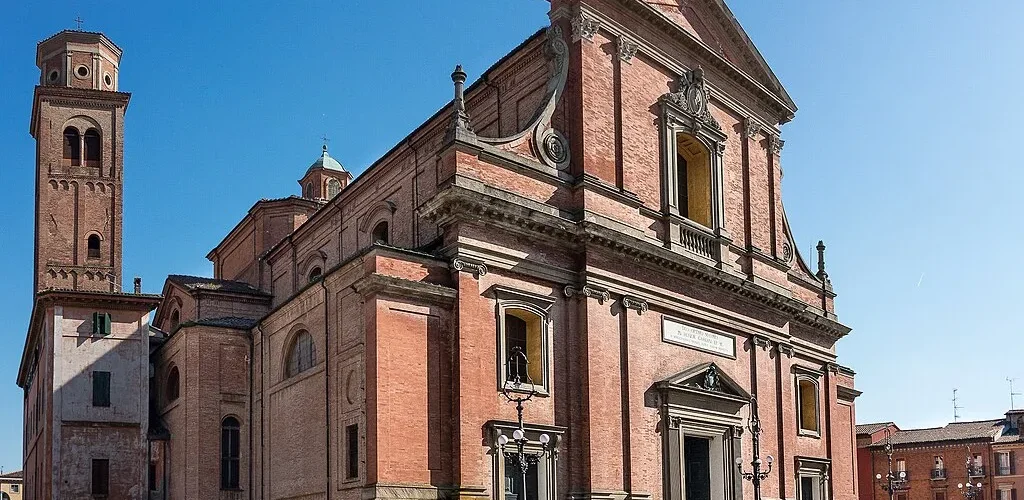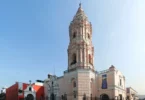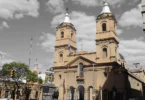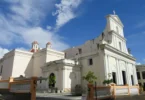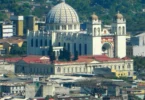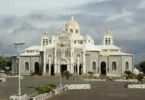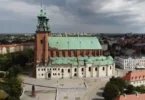Introduction
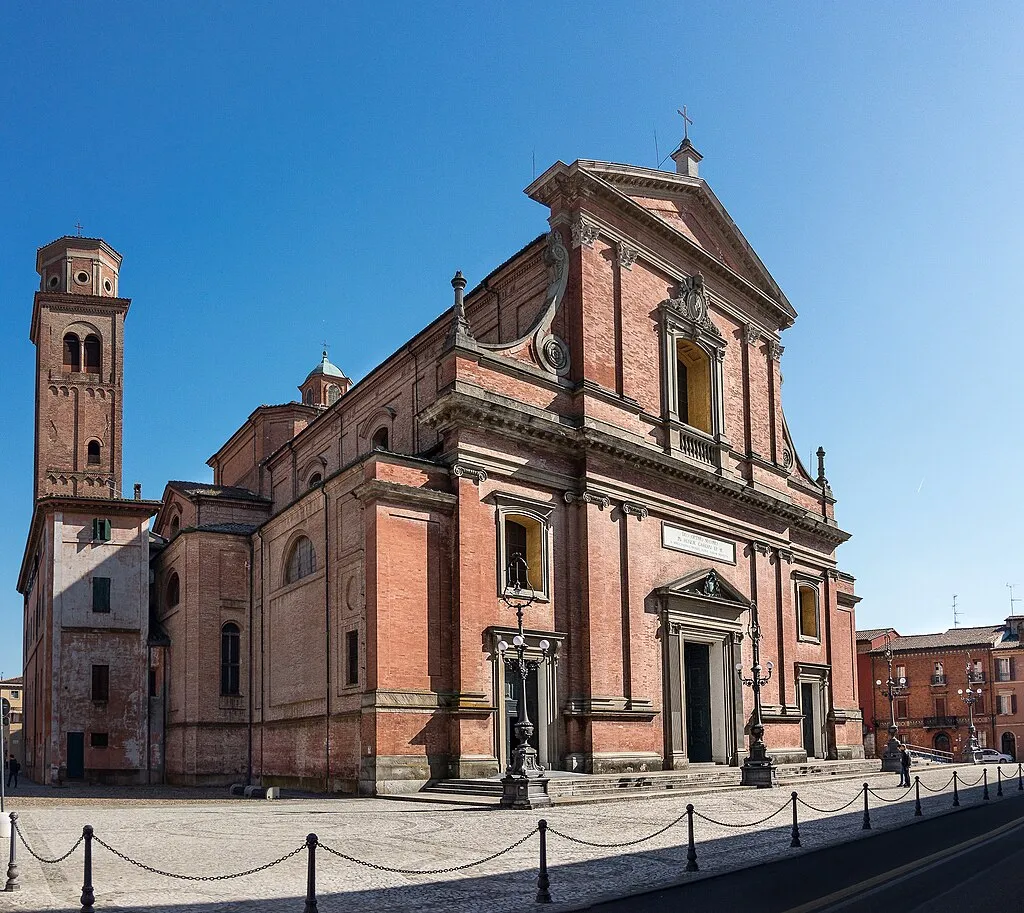
The Comacchio Cathedral (Italian: Duomo di Comacchio; Cattedrale di San Cassiano), also known as the Basilica of San Cassiano, is a Baroque Roman Catholic cathedral located in the town of Comacchio, in the province of Ferrara, Emilia-Romagna, Italy. Dedicated to Saint Cassian of Imola (San Cassiano), the cathedral serves as an important religious site in the region. Once the seat of the Bishops of Comacchio, the cathedral became a co-cathedral in 1986 under the Archdiocese of Ferrara-Comacchio. Despite this change in status, it continues to be a central place of Catholic worship in the area. On December 17, 1981, the cathedral was granted the honor of being elevated to a minor basilica by Pope John Paul II through an apostolic rescript, further solidifying its religious importance.
The cathedral houses the relics of Saint Cassiano and Saint Pier Crisologo, two revered figures whose remains are venerated by the faithful. Over the centuries, three notable bishops who served as bishops of Imola maintained their titles even after being elected to the papacy: Pope Alexander VII (elected in 1655), Pope Pius VII (elected in 1800), and Pope Pius IX (elected in 1846). As the main church of Comacchio and one of the principal churches of the Archdiocese of Ferrara-Comacchio, the Cathedral of San Cassiano Martire continues to be a vital center of faith and heritage in the region.
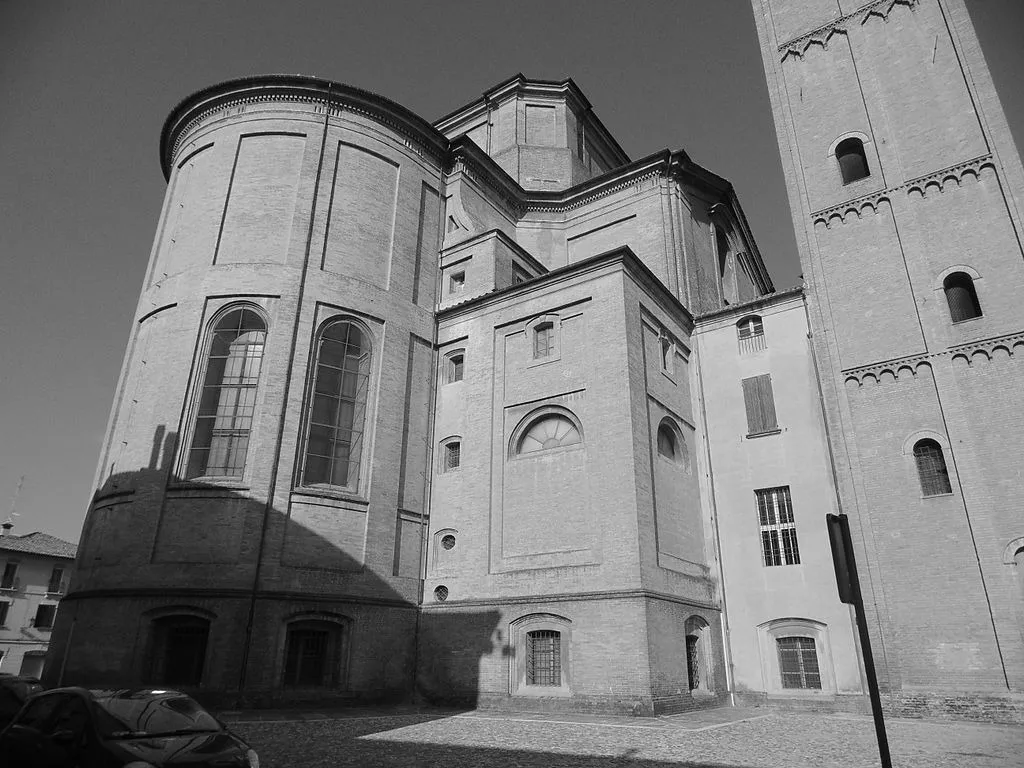
Early Construction and Romanesque Roots
The origins of the Comacchio Cathedral date back to 708 when the first cathedral was built under Bishop Vincenzo. This early church, constructed in a pre-Romanesque style, stood on the same site as the current cathedral. It was a three-nave structure supported by marble columns, and the capitals of these columns featured the emblem of the water sparrow, symbolizing the city’s coat of arms. This cathedral remained intact until around 1200, when it was remodeled in the Gothic style. The structure remained in this form until the middle of the 17th century.
Demolition and Baroque Reconstruction
In 1659, after centuries of continuous restoration and the building’s deteriorating condition, it was decided to demolish the old cathedral. The new cathedral’s construction began on March 25, 1659, under the leadership of Cardinal Legate Giuseppe Renato Imperiali. The project, envisioned by architect Angelo Cerruti, aimed to create a Baroque-style structure. Despite the initiation of construction, over 35 years passed before the foundations were excavated and masonry work began. After decades of work, the new cathedral was solemnly consecrated on April 12, 1740, by Bishop Giovanni Cavedi.
Elevation to Minor Basilica
The cathedral continued to serve as a place of worship and religious significance over the centuries. On October 13, 1961, it was elevated to the dignity of a minor basilica by Pope John XXIII, further solidifying its importance in the region.
Architectural Archives and Historical Significance
The Comacchio Cathedral houses the episcopal archive of Comacchio, the capitular archive, and the archive of the archpriesthood, which preserve valuable historical and religious records. The cathedral also remains the main place of worship for the faithful in Comacchio.
Early History : Foundation and Romanesque Period
The first cathedral of the Diocese of Imola was situated in Castrum Sancti Cassiani, a town located west of the city. In February 1177, Imola attacked and razed Castrum Sancti Cassiani to the ground. Afterward, Bishop Enrico of Imola made arrangements with the Municipality of Imola to begin constructing a new cathedral within the city walls. On October 24, 1271, this cathedral was consecrated, marking an important moment in the city’s history.
18th and 19th Century Renovations : Restoration in the 18th Century
The cathedral underwent several interventions due to structural instability in the mid-18th century. In 1763, it was decided that the church should be completely restructured. The task was entrusted to the prominent architect Cosimo Morelli, who was heavily involved in the urban transformation of Romagna during this period. The restoration was completed in two phases: from 1765 to 1769, the choir, presbytery, dome, and crypt were reconstructed, followed by the remaining body of the church between 1775 and 1781. The restored cathedral was consecrated on May 28, 1782 by Pope Pius VI.
Facade Design and Completion
The design for the cathedral’s facade was entrusted to the Roman architect Filippo Antolini, and the work was completed in 1850, giving the cathedral its iconic front.
Restoration and Construction of the Churchyard : Late 19th Century Renovations
In anticipation of the Jubilee of 1900, significant restoration work was carried out on the cathedral. The marble flooring was entirely redone, and repairs were made to the bell tower. In 1900-1901, a new cobblestone pavement was installed around the cathedral’s perimeter. The work was directed by engineer Remigio Mirri and featured a design with geometric motifs and pebbles of different colors. Notable features included trachyte paths leading to the cathedral’s entrances and a large cameo with the inscription “ANNO SACRO MCM” to commemorate the Jubilee. The cathedral’s reopening occurred on August 12, 1901, the eve of St. Cassian’s feast day.
Post-World War II and Modern Developments
After World War II, the area surrounding the cathedral was repurposed to build a car park. However, in 2010, Bishop Tommaso Ghirelli initiated a project to restore the area to its original use. Restoration work on the cobblestones, which had significantly degraded, was carried out under the direction of engineer Paolo Palladini. The project was completed in 2011, in time for the feast of San Cassiano.
Restoration for the Jubilee of 2000 (1998–2000)
In preparation for the Jubilee of 2000, the diocese of Comacchio commissioned architect Alessandro Bettini to oversee a comprehensive renovation of the cathedral. The extensive restoration work included the reconstruction of the roofing, along with the installation of a new anti-bird system to preserve the building’s structure. The facade of the cathedral was fully restored to highlight its Baroque elegance, while a new lighting system was installed to illuminate both the main hall and the crypt, enhancing the cathedral’s beauty and visibility. Additionally, the Chapel of the Immaculate Conception underwent careful architectural restoration, ensuring its historical integrity. As part of the updates, polygonal marble steps were added to the Bishop’s Chair, further elevating its importance. These renovations not only preserved the cathedral’s architectural legacy but also reinforced its significance as a central religious and cultural site.
Architecture of Cathedral of San Cassiano, Imola, Italy
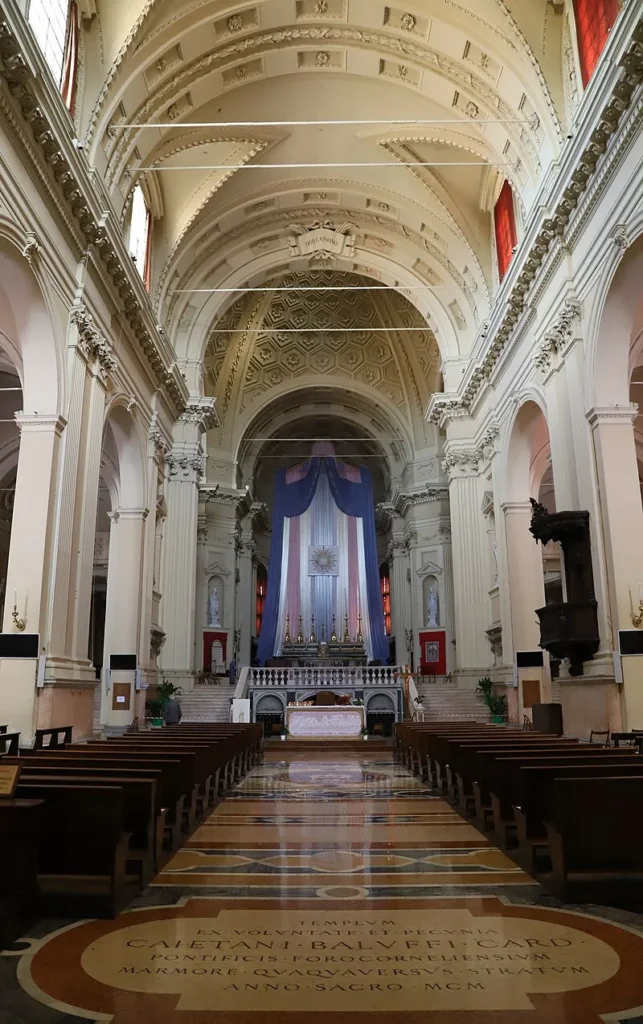
Architectural Style : Baroque architecture.
The Comacchio Cathedral, also known as the Basilica of San Cassiano, boasts a simple yet striking brick facade, with the exception of the capitals, pilasters, bases of the pedestals, and the central cornice, all of which are crafted from Istrian stone. This choice of materials adds a level of refinement to the cathedral’s exterior.
Interior of the Cathedral
The interior of the cathedral is equally impressive, with its single nave and twelve chapels arranged along both sides. These chapels feature a variety of valuable artwork and sacred objects. Among the notable pieces are 18th-century canvases by the renowned Biagio Bovi, a wooden crucifix by the 17th-century sculptor Germano Cignani, and a 15th-century sculpture of Saint Lucia, a significant piece from the Venetian school. The apse of the cathedral is home to a magnificent 18th-century marble altar adorned with winged angels and the wooden statue of the Martyr Cassiano, the patron saint of both the town and the diocese. Above the entry portal stands an organ, built in 1728 in Modena by Giovanni Domenico Traeri, adding a harmonious musical element to the cathedral’s sacred atmosphere.
Bell Tower
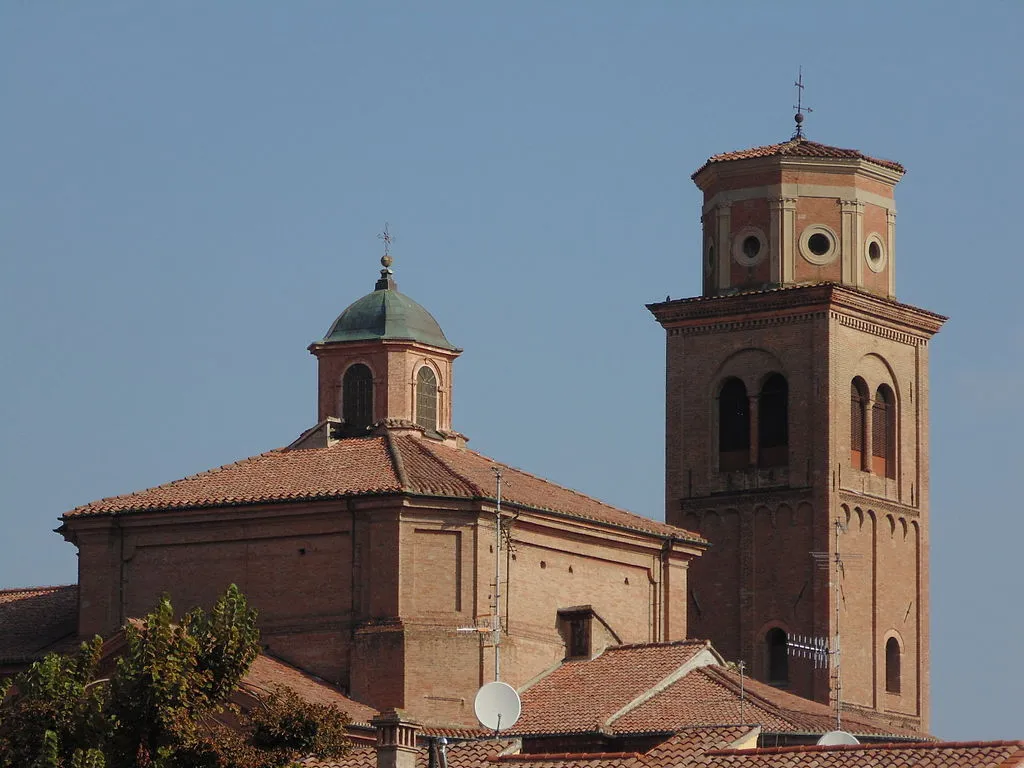
The cathedral’s bell tower has an interesting history. It was initially constructed in 1751 by architect Giorgio Fossati but tragically collapsed in 1757. A lower tower was eventually rebuilt, and the structure was completed in 1868, incorporating the massive base of the original tower that had remained intact after the collapse.
Chapels of Comacchio Cathedral
The Comacchio Cathedral features a number of chapels, each with its own distinct history and artistic significance. These chapels are dedicated to various saints, including Saint John Bosco, Saint Anne, Saint Joseph, and Our Lady of Lourdes, reflecting the rich religious heritage of the region. The cathedral also houses important spaces like the Sacred Heart of Jesus Chapel and the Blessed Sacrament Chapel, both of which emphasize the central themes of Christian worship. Artistic treasures are found in these chapels, including significant works such as the Sorrowful Chapel, the Baptistery, and the Sant’Omobono and the Shrine of Santa Lucia, each adorned with devotional artwork. These chapels serve not only as spaces of worship but also as key elements in the cathedral’s cultural and spiritual legacy, offering visitors a deeper connection to the faith and history that the cathedral represents.
Canonical Titles and Ecclesiastical Traditions of Comacchio Cathedral
The Comacchio Cathedral, as a co-cathedral, holds a number of important canonical titles, which are associated with various ecclesiastical roles and responsibilities. Among these titles are San Cassiano Martyr for the archpriesthood, San Pio V for the archdeaconry, and other revered saints such as San Girolamo, San Clemente Pope, and San Francesco di Paola. Additional titles include San Cristoforo, Sant’Antonio, Blessed Sacrament, Holy Rosary, San Giuseppe, Santa Gertrude, and San Giovanni Nepomuceno, traditionally reserved for the Penitentiary. The cathedral’s dignitaries, including the archpriest and archdeacon, are granted prelatical habits, with titles such as Monsignor and the privilege of using the palmatoria (a liturgical implement). The canons, the cathedral’s clergy, wear distinctive purple mozetta over a rochet adorned with red silk cuffs. These traditional garments and titles reinforce the cathedral’s status and its central role in the religious and cultural life of the community.
Interior and Chapels of Comacchio Cathedral
The interior of Comacchio Cathedral is distinguished by its spacious three-nave layout, with the central nave being notably wide, allowing for an impressive sense of grandeur. The presbytery is the focal point of the church, framed by two symmetrical staircases leading up from the side naves, while a much larger central staircase descends to the crypt, creating a dynamic flow between the different areas of the church.
On the left side of the cathedral:
- The first chapel preserves a rare medieval artifact: a baptismal font from the early 16th century, possibly crafted by Tuscan artisans. The font is adorned with reliefs depicting Saint John the Baptist and another bishop, likely Saint Cassiano, reflecting the cathedral’s deep historical roots.
- The second chapel features an altarpiece depicting Saint Peter and Saint Paul, dating from the 19th century. This work is likely the creation of the Camuccino workshop, characteristic of the period’s ecclesiastical art.
- The third chapel houses a fresco titled Madonna delle Laudi, a devotional piece from the early 15th century, offering a glimpse into the religious art of the time.
- In the fourth chapel, there is a significant painting of the Assumption, attributed to Jacopo Bertucci, adding to the richness of the cathedral’s art collection.
On the right side of the cathedral:
- The first chapel showcases an altarpiece of The Supper at Emmaus, painted by Ignazio Zotti in 1850, offering a dramatic depiction of this biblical scene.
- The second chapel contains a wooden Crucifix from the late 15th century, attributed to the Tuscan school, later painted by Marco Cattani in 1524. This crucifix serves as a poignant example of religious devotion in the late Middle Ages.
- In the third chapel, there is a painting of the Holy Family with Saint John the Baptist, attributed to Giacomo Zampa from Forlì, enhancing the sacred atmosphere of the cathedral with its vivid imagery.
These chapels, each with its distinct works of art, contribute to the cathedral’s significance as a historical and spiritual landmark.
Presbytery and High Altar
The presbytery features notable sepulchral monuments, including those of Lippo and Francesco Alidosi, embedded into the walls. At the high altar, magnificent candlesticks donated by Pope Pius IX stand out. Behind the altar, there is a canvas by Pietro Tedeschi, depicting the Martyrdom of Saint Cassian.
The Crypt
The cathedral’s crypt houses three marble urns, created between 1698 and 1704, and designed by Giuseppe Maria Mazza. These urns contain the relics of four saints from Imola: Cassiano, Pier Crisologo, Proietto, and Maurelio. The crypt also contains the remains of Girolamo Riario, the first husband of Caterina Sforza, who was killed in Forlì in 1488. The crypt is a place of reverence, with a statue of the Immaculate Conception by Filippo Scandellari and paintings of various saints, including Apollinare, Cosma, Carlo Borromeo, and Terenzio.
Renovations for the Jubilee of 2000
The cathedral underwent significant renovations in preparation for the Jubilee of 2000, which included the complete reconstruction of the roofing, the installation of a new anti-bird system, a facade restoration, and the addition of new lighting. Additionally, the Chapel of the Immaculate Conception received architectural restoration, and polygonal marble steps were added to the Bishop’s Chair, ensuring the cathedral’s continued preservation and enhancing its role as a place of worship and pilgrimage.
Feast Day
Feast Day : 13th August
The feast day of the Cathedral of San Cassiano in Imola, Italy, is celebrated on August 13th in honor of Saint Cassian, the patron saint of Imola. This date is significant in the local religious calendar as it marks the commemoration of Saint Cassian’s martyrdom and his association with the city.
Church Mass Timing
Monday : 9:00 AM.
Tuesday : 9:00 AM.
Wednesday : 9:00 AM.
Thursday : 9:00 AM.
Friday : 9:00 AM.
Saturday : 5:00 PM.
Sunday : 7:00 AM, 9:00 AM and 6:00 PM.
Church Opening Time:
Monday : 07:30 am – 11:30 am., 4:00 pm – 6:00 pm.
Tuesday : 07:30 am – 11:30 am., 4:00 pm – 6:00 pm.
Wednesday : 07:30 am – 11:30 am., 4:00 pm – 6:00 pm.
Thursday : 07:30 am – 11:30 am., 4:00 pm – 6:00 pm.
Friday : 07:30 am – 11:30 am., 4:00 pm – 6:00 pm.
Saturday : 07:30 am – 11:30 am., 4:00 pm – 6:00 pm.
Sunday : 07:30 am – 11:30 am., 4:00 pm – 6:00 pm.
Contact Info
Address :
Cathedral of San Cassiano
Piazza del Duomo, 40026 Imola BO, Italy.
Phone : +39 0542 22146
Accommodations
Connectivities
Airway
Cathedral of San Cassiano, Imola, Italy, to Bologna Guglielmo Marconi Airport, distance between 40 min (47.4 km) via Tangenziale nord di Bologna and A14/E45.
Railway
Cathedral of San Cassiano, Imola, Italy, to Imola Railway Station, distance between 7 min (1.9 km) via Viale G. Carducci.

